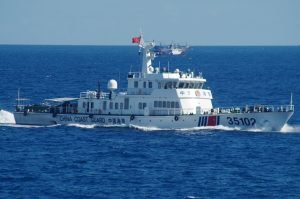TSURUTA Jun

September 11 will mark the 10th anniversary of the Japanese government purchase of the Senkaku Islands (specifically, Uotsuri Island, Minamikojima Island and Kitakojima Island) from their previous owners.
Even before the 2012 nationalization, Chinese government vessels were operating in the surrounding waters, but recent years have seen a normalization of China Coast Guard (CCG) vessels making incursions into the territorial waters around the Senkaku, navigating through the contiguous zone and approaching and following Japanese fishing boats.
In 2021, CCG vessels sailed through the contiguous zone a total of 332 days. This was second only to the record 333 days in 2020. This year, as of August 19, CCG vessels had entered the contiguous zone on 220 days, on pace for a new record.
Meanwhile, CCG vessels approached and followed Japanese fishing boats in territorial waters around the Senkaku Islands 18 times in 2021, more than double the eight of 2020.
Japan responds to the entry of CCG vessels into the territorial waters around the Senkaku Islands by demanding that CCG vessels – which claim that they are engaged in law enforcement activity in accordance with Chinese domestic laws and regulations – to withdraw on the basis of the United Nations Convention on the Law of the Sea (UNCLOS).
At some point, it is quite possible that CCG crew may land on one of the islands. Moreover, with the number of CCG vessels approaching and following Japanese fishing boats increasing, it is important to note that CCG crew may also seek to enforce Chinese laws and regulations against Japanese fishing boats (for instance, with on-site inspections or seizures of Japanese fishing boats). While the operation of Japanese fishing boats in the waters surrounding the Senkaku Islands is a legitimate exercise of rights, it should be noted that China could seek to build a track record of enforcing Chinese laws and regulations. Japan needs to be prepared to deal with this appropriately and effectively.
Japan and China disagree on the territorial sovereignty of the Senkaku Islands (known in China as the Diaoyu Islands), with differences that are not easy to reconcile. The Japanese government does not recognize the existence of any international dispute over the territorial sovereignty of the islands. It is important that Japan manages the different opinions of Japan and China by gradually attenuating the confrontations in the surrounding waters through diplomatic means, while simultaneously ensuring that confrontations do not escalate into clashes.
In recent years, CCG vessels have become larger and more heavily armed. Ships belonging to the People’s Liberation Army Navy’s are also being converted into CCG vessels. According to material published by the Japan Coast Guard (JCG), the number of large CCG vessels above the 1,000-ton class (full load displacement) was 131 as of the end of December 2020, than three times the number of a decade ago. This is about twice the number of large JCG patrol vessels above the 1,000-ton class (gross tonnage).
The JCG is bolstering its own coast guard system by building large new patrol vessels. However, Japan to simply unable to match China in building more large patrol vessels. Constructing these vessels and training their crews takes time and money. Once the vessels have been built, there is also the issue of securing reliable repair and crew members.
How long will the current situation surrounding the Senkaku Islands continue? That is unclear. But if we accept that tensions may persist for another decade or two, Japan needs to seek innovative approaches to strengthening its coast guard system.
No comments:
Post a Comment